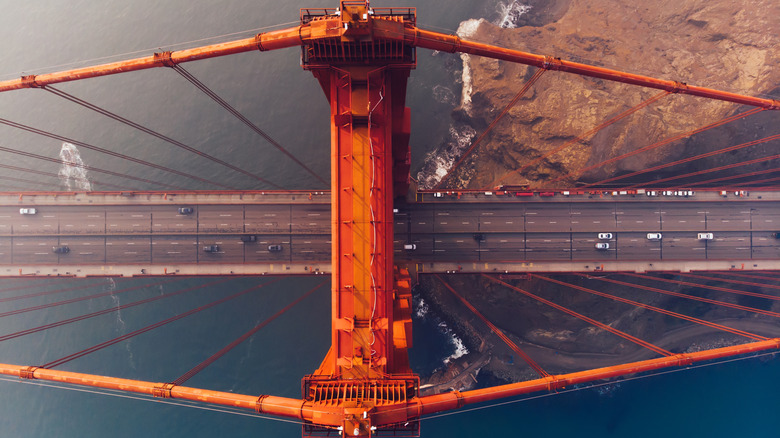Here's What Caused The Famous Golden Gate Bridge Arches To Flatten In 1987
As any seasoned traveler will know, wherever you are in the world, there are certain things that you just don't miss seeing, or doing, or eating. It may be something of a cliché to visit the Eiffel Tower while in Paris, the Colosseum while in Rome, or the Taj Mahal in Agra, but wherever possible, trips should be adapted to include them, if not built around them. The United States is home to a tremendous array of can't-miss sights, too, both those built by nature and those by talented engineers, architects, and laborers.
All too often, bridges aren't thought of in this way. They're a convenient means of getting from A to B, and often an expensive and rather congested one at that. Nevertheless, some bridges are popular tourist attractions in and of themselves. The Golden Gate Bridge of San Francisco is one example. Completed in 1937, Britannica reports, it was the largest suspension bridge ever built, in both height and length. Britannica goes on to state that the then-unprecedented project took around four years to complete, and was fraught with peril.
Contending with the rushing waters and unpredictable weather, coupled with the need to ensure that every element of the bridge would be as sturdy as possible, posed great dangers to the workers, per Britannica. Joseph B. Strauss was the overseer of the building work, and the vast net he designed as a lifeline for builders who lost their footing reportedly saved 19 lives over the course of the work. Unfortunately, 11 other workers lost their lives during the bridge's construction.
Building the bridge
History states that those who constructed the bridge were under no doubt about just how dangerous their work was. Those 19 people who were "caught" and saved by the net of Strauss' design were said to have joined the Halfway to Hell Club.
Despite its formidable size, though, it has trembled under the weight of its load at times. One day in 1987, it seems, the Golden Gate Bridge was so packed with people that it sank into the ground and its arches were somewhat crushed. A celebration was held in 1987 to mark the Golden Gate Bridge's half-centenary. Most unfortunately, though, all the footfall and hoopla of the day actually caused the bridge to start sinking into the ground.
On May 24, 1987, per SFGate, the Golden Gate Bridge 50th Anniversary Bridge Walk took place, arranged by the bridge district's board of directors. The intent was, naturally, to draw even more crowds than the stunning bridge typically does and some very heavy media attention to boot. It all ended in frightening fashion.
The Golden Gate Bridge wasn't in danger of collapsing, but it felt that way
The publication reports that a crowd of around 800,000 gathered, around 10 times as many as expected. Close to half of those people, at 300,000, proceeded to try to walk across the bridge itself. The inevitable result? Pedestrians were crammed together for the length of the structure, nobody able to move anywhere.
The Bay Area News Group reports (via The Mercury News) that suspension bridges are designed to have some "give." There is a slight upward curve to the roadway. This flexibility is crucial in cases such as the Golden Gate Bridge, which must be able to withstand harsh winds. When an unprecedented number of people tried to cross at once on this special day, according to the outlet, "stress on the bridge stretched the steel cables, pulled the towers inward and pushed the roadway down by seven feet."
The New York Times stated that, had quick-off-the-mark security not jumped into action and stopped the rest of the assembled crowds from jostling their way onto the bridge, damage could have been terrible. Board president Gary Giacomini confessed, according to the outlet, that "maybe the bridge would have fallen down." Ultimately, the newspaper reported, engineers had determined that the bridge wasn't in danger of collapsing, and over 1 million people were there to celebrate that historic day. Per History, though, it was a terrifying thing to witness: The arch was squashed flat as the center of the bridge sagged.


